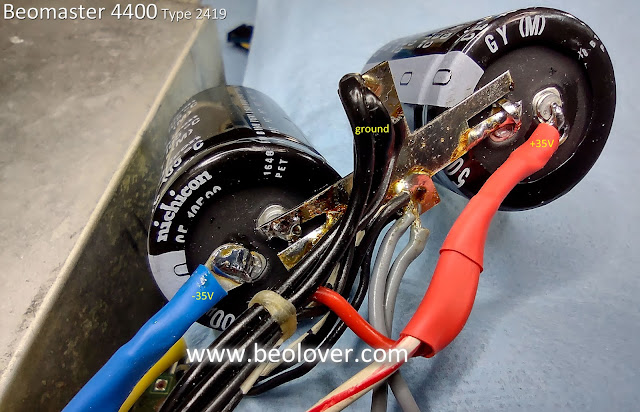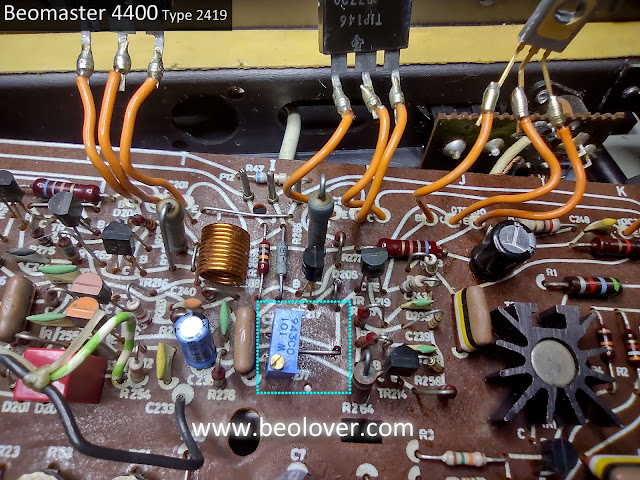I did look up the B&O service manual addendum on the change with the switch panel.
According to that documentation the "early serial number" switch assemblies are for Beomaster 4400 serial numbers prior to SN 1524001. Units with serial numbers 1524001 and on have the new switch assemblies.
That bears out on the Beomaster 4400 units I have seen. The serial number for the Beomaster 4400 of this project is 1510043.
Here are some photos of the Beomaster 4400 front panel for both versions side by side.
From the front the difference is in the way the slider controls mount to the front panel.
The later serial number panel mounted the controls with screws from the front while the early serial number panel used metal spring clips. For that reason the early serial number front panels included a narrow mounting bracket for the slider controls to rest on.
The metal button panel frame that the switch assembly mounts to also changed due to the different style of switch actuators.
This picture shows the type of slider controls the Beomaster 4400 uses for the early serial number and later serial number units.
On two the circuit boards and wiring.
Both types of front panels have a small LED glued in place for the Stereo Indicator.
It is difficult to detach that LED assembly when disassembling the front panel so I started cutting the two wires that connect to the LED assembly. When reassembling the panel I install a small 2-pin connector for the cut wires. That makes it a little easier in servicing the front panel.
The switch assembly is mounted to the front panel on a metal, button panel frame.
It is secured with two screws.
The important thing here is to make sure all of the plastic switch actuators are pressed against their respective push buttons.
It is secured with two screws.
The important thing here is to make sure all of the plastic switch actuators are pressed against their respective push buttons.
Now that the switch assembly is secured onto the front panel it is a good idea to double-check the mechanical operation of the switches again.
While I was working on the front panel assembly I took a little detour to replace the two 10,000uF electrolytic capacitors for the ±35 VDC output amplifier rails. These are the two capacitors that are mounted on a bracket just to the side of PCB 5.
I also took a little time to install the two 100Ω trimmer resistors for the no-load current adjustment of the output amplifier. On those two trimmers I always go with multi-turn trimmers as they are easier to fine tune.
Here is the left channel trimmer.
Here is the right channel trimmer.
Returning to the reassembly of the front panel I decided to prepare the new incandescent lamps in the front panel wire harness.
Three of the five original lamps still worked but since I have to replace two I am going ahead and replacing all five with proper lamps from Martin's Beoparts store.
Here are the original lamps removed.
Three of the five original lamps still worked but since I have to replace two I am going ahead and replacing all five with proper lamps from Martin's Beoparts store.
Here are the original lamps removed.
Here are the new lamps installed.
The next step of the front panel reassembly is to re-attach the circuit boards that mount to the switch assembly. They are how the switches electrically connect to the Beomaster.
First is the PCB 6, 2-piece board.
It has a normal, rigid PCB part and a flexible part to connect to the FM tuner preset dials.
The next PCB to attach to the switch assembly is PCB 9.
Here is a picture of the circuit boards reattached to the switch panel.
The front panel reassembly has gone smoothly so far.
It is at the point where the wire harnesses get reattached.
In some cases that just means plugging in some connectors but unfortunately for me it also means quite a few loose wires that do not have a connector.
That is the reason you have to take a lot of photos during the de-soldering of those wires when the front panel is being disassembled.
I have those of course and my task for next time is to gather all of that information and carefully solder all of the individual, loose wires back in place.



















No comments:
Post a Comment
Comments and suggestions are welcome!